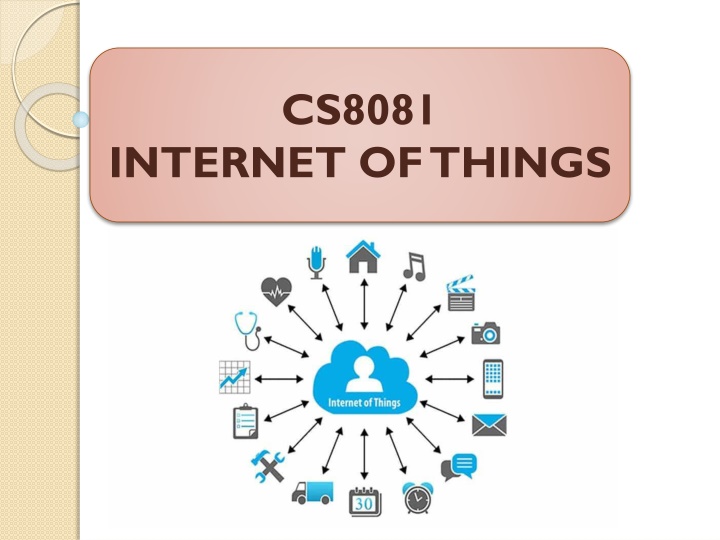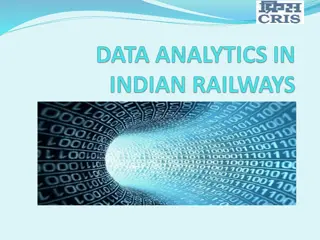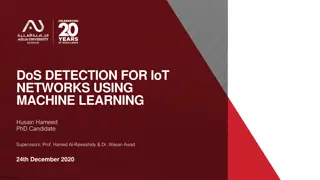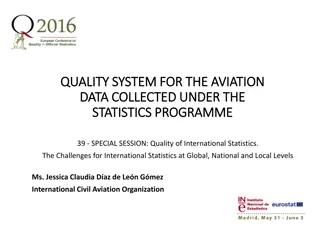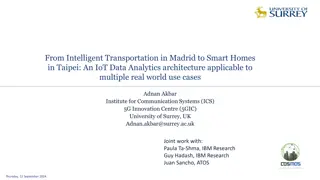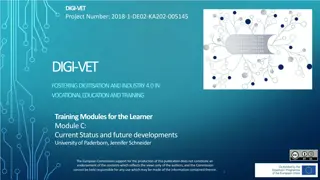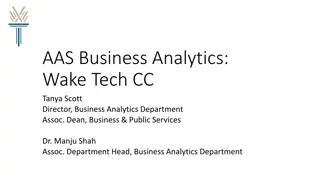An Introduction to Data Analytics for IoT in Aviation Industry
In the world of IoT, massive amounts of data are generated by sensors, posing challenges in transportation and data management. Commercial jet engines equipped with thousands of sensors produce terabytes of data daily. Understanding structured vs. unstructured data is crucial for implementing effective analytics solutions in IoT networks.
Download Presentation

Please find below an Image/Link to download the presentation.
The content on the website is provided AS IS for your information and personal use only. It may not be sold, licensed, or shared on other websites without obtaining consent from the author.If you encounter any issues during the download, it is possible that the publisher has removed the file from their server.
You are allowed to download the files provided on this website for personal or commercial use, subject to the condition that they are used lawfully. All files are the property of their respective owners.
The content on the website is provided AS IS for your information and personal use only. It may not be sold, licensed, or shared on other websites without obtaining consent from the author.
E N D
Presentation Transcript
CS8081 INTERNET OF THINGS
INTERNET OF THINGS UNIT IV DATA ANALYTICS AND SUPPORTING SERVICES Structured Vs Unstructured Data and Data in Motion Vs Data in Rest Role of Machine Learning No SQL Databases Hadoop Ecosystem Apache Kafka, Apache Spark Edge Streaming Analytics and Network Analytics Xively Cloud for IoT, Python Web Application Framework Django AWS for IoT System Management with NETCONF-YANG 106
An Introduction to Data Analytics for IoT In the world of IoT, the creation of massive amounts of data from sensors is common and one of the biggest challenges not only from a transport perspective but also from a data management standpoint. A great example of the deluge of data that can be generated by IoT is found in the commercial aviation industry and the sensors that are deployed throughout an aircraft
Example Modern jet engines, similar to the one shown in Figure may be equipped with around 5000 sensors. Therefore, a twin engine commercial aircraft with these engines operating on average 8 hours a day will generate over 500 TB of data daily, and this is just the data from the engines! Aircraft today have thousands of other sensors connected to the airframe and other systems. In fact, a single wing of a modern jumbo jet is equipped with 10,000 sensors. Petabyte (PB) of data per day per commercial airplane. Across the world, there are approximately 100,000 commercial flights per day. The amount of IoT data coming just from the commercial airline business is overwhelming
Structured Versus Unstructured Data
Smart objects in IoT networks generate both structured and unstructured data. Structured data is more easily managed and processed due to its well-defined organization. On the other hand, unstructured data can be harder to deal with and typically requires very different analytics tools for processing the data. Being familiar with both of these data classifications is important because knowing which data classification you are working with makes integrating appropriate data analytics solution much easier. with the
Data in Motion Versus Data at Rest As in most networks, data in IoT networks is either in transit ( data in motion ) or being held or stored ( data at rest ). Examples of data in motion include traditional client/server exchanges, such as web browsing and file transfers, and email. Data saved to a hard drive, storage array, or USB drive is data at rest.
From an IoT perspective, the data from smart objects is considered data in motion as it passes through the network en route to its final destination. This is often processed at the edge, using fog computing. When data is processed at the edge, it may be filtered and deleted or forwarded on for further processing and possible storage at a fog node or in the data center. Data does not come to rest at the edge.
When data arrives at the data center, it is possible to process it in real-time, just like at the edge, while it is still in motion. Tools with this sort of capability, such as Spark, Storm, and Flink, are relatively nascent compared to the tools for analyzing stored data.
Application of Value and Complexity Factors to the Types of Data Analysis
IoT Data Analytics Challenges Scaling problems: Due to the large number of smart objects in most IoT networks that continually send data, relational databases can grow incredibly large very quickly. This can result in performance issues that can be costly to resolve, often requiring more hardware and architecture changes. Volatility of data: With relational databases, it is critical that the schema be designed correctly from the beginning. Changing it later can slow or stop the database from operating. Due to the lack of flexibility, revisions to the schema must be kept at a minimum. IoT data, however, is volatile in the sense that the data model is likely to change and evolve over time. A dynamic schema is often required so that data model changes can be made daily or even hourly.
Machine Learning One of the core subjects in IoT is how to makes sense of the data that is generated. Because much of this data can appear incomprehensible to the naked eye, specialized tools and algorithms are needed to find the data relationships that will lead to new business insights. This brings us to the subject of machine learning (ML).
ML is indeed central to IoT. Data collected by smart objects needs to be analyzed, and intelligent actions need to be taken based on these analyses. Performing this kind of operation manually is almost impossible (or very, very slow and inefficient). Machines are needed to process information fast and react instantly when thresholds are met.
Machine Learning Overview Machine learning is, in fact, part of a larger set of technologies commonly grouped under the term artificial intelligence (AI). This term used to make science fiction amateurs dream of biped robots and conscious machines, or of a Matrix-like world where machines would enslave humankind. AI includes any technology that allows a computing system intelligence using any technique, from very advanced logic to basic if-then-else decision loops. to mimic human
A simple example is an app that can help you find your parked car. Simple static rule set In more complex cases, static rules cannot be simply inserted into the program because they require parameters that can change or that are imperfectly understood. A typical example is a dictation program that runs on a computer. The program is configured to recognize the audio pattern of each word in a dictionary, but it does not know your voice s accent, tone, speed, and so on.
You predetermined sentences to help the tool match well-known words to the sounds you make when you say the words. This process is called machine learning. ML is concerned with any process where the computer needs to receive a set of data that is processed to help perform a task with more efficiency. need to record a set of
Supervised Learning Unsupervised Learning Supervised learning algorithms are trained using labeled data. Unsupervised learning algorithms are trained using unlabeled data. Supervised learning model takes direct feedback to check if it is predicting correct output or not. Unsupervised learning model does not take any feedback. Supervised learning model predicts the output. Unsupervised learning model finds the hidden patterns in data. In supervised learning, input data is provided to the model along with the output. In unsupervised learning, only input data is provided to the model. The goal of supervised learning is to train the model so that it can predict the output when it is given new data. The goal of unsupervised learning is to find the hidden patterns and useful insights from the unknown dataset. Supervised learning needs supervision to train the model. Unsupervised learning does not need any supervision to train the model.
Supervised Learning Supervised learning can be categorized in Classification and Regression proble ms. Supervised learning can be used for those cases where we know the input as well as corresponding outputs. Supervised learning model produces an accurate result. Unsupervised Learning Unsupervised Learning can be classified in Clustering and Associations proble ms. Unsupervised learning can be used for those cases where we have only input data and no corresponding output data. Unsupervised learning model may give less accurate result as compared to supervised learning. Unsupervised learning is more close to the true Artificial Intelligence as it learns similarly as a child learns daily routine things by his experiences. It includes various algorithms such as Clustering, KNN, and Apriori algorithm. Supervised learning is not close to true Artificial intelligence as in this, we first train the model for each data, and then only it can predict the correct output. It includes various algorithms such as Linear Regression, Logistic Regression, Support Vector Machine, Classification, Decision tree, Bayesian Multi-class
Neural networks ML methods that mimic the way the human brain works. When you look at a human figure, multiple zones of your brain are activated to recognize colors, movements, facial expressions, and so on. Your brain combines these elements to conclude that the shape you are seeing is human. Neural networks mimic the same logic
Introduction to NoSQL Databases A database Management System provides the mechanism to store and retrieve the data. There are different kinds of database Management Systems: 1. RDBMS (Relational Database Management Systems) 2. OLAP (Online Analytical Processing) 3. NoSQL (Not only SQL)
What is a NoSQL database? NoSQL databases are different than relational databases like MQSql. In relational database you need to create the table, define schema, set the data types of fields etc before you can actually insert the data. In NoSQL you don t have to worry about that, you can insert, update data on the fly.
One of the advantage of NoSQL database is that they are really easy to scale and they are much faster in most types of operations that we perform on database. There are certain situations where you would prefer relational database over NoSQL, however when you are dealing with huge amount of data then NoSQL database is your best choice.
Limitations of Relational databases 1. In relational database we need to define structure and schema of data first and then only we can process the data. 2. Relational database systems provides consistency and integrity of data by enforcing ACID properties (Atomicity, Consistency, Isolation and Durability ). There are some scenarios where this is useful like banking system. However in most of the other cases these properties are significant performance overhead and can make your database response very slow. 3. Most of the applications store their data in JSON format and RDBMS don t provide you a better way of performing operations such as create, insert, update, delete etc on this data. On the other hand NoSQL store their data in JSON format, which is compatible with most of the today s world application.
What are the advantages of NoSQL High scalability High Availability Here are the types of NoSQL databases and the name of the databases system that falls in that category. MongoDB falls in the category of NoSQL document based database. Key Value Store: Memcached, Redis, Coherence Tabular: Hbase, Big Table, Accumulo Document based: MongoDB, CouchDB, Cloudant
When to go for NoSQL When you would want to choose NoSQL over relational database: When you want to store and retrieve huge amount of data. The relationship between the data you store is not that important The data is not structured and changing over time Constraints and Joins support is not required at database level The data is growing continuously and you need to scale the database regular to handle the data.
HADOOP Overview Apache Hadoop is an open source framework intended to make data easier. Hadoop has made its place in the industries and companies that need to work on large data sets which are sensitive and needs efficient handling. Hadoop is a framework that enables processing of large data sets which reside in the form of clusters. Being a framework, Hadoop is made up of several modules that are supported by a large ecosystem of technologies. interaction with big
HADOOP ARCHITECTURE Vs ECOSYSTEM
Hadoop Architecture Hadoop has two major layers namely MapReduce Processing/Computation layer Storage layer Hadoop Distributed File System HDFS
Hadoop Ecosystem Hadoop Ecosystem is a platform or a suite which provides various services to solve the big data problems. It includes Apache projects and various commercial tools and solutions. There are four Hadoop i.e. HDFS, MapReduce, YARN, and Hadoop Common Most of the tools or solutions are used to supplement or support these major elements. All these tools work collectively to provide services such as absorption, analysis, storage and maintenance of data etc. major elements of
Following are the components that collectively form a Hadoop ecosystem HDFS:Hadoop Distributed File System YARN:Yet Another Resource Negotiator MapReduce: Programming based Data Processing Spark: In-Memory data processing PIG, HIVE: Query based processing of data services HBase:NoSQL Database Mahout, Spark MLLib: Machine Learning algorithm libraries Solar, Lucene: Searching and Indexing Zookeeper: Managing cluster Oozie: Job Scheduling
Hadoop Distributed File System HDFS is the primary or major component of Hadoop ecosystem and is responsible for storing large data sets of structured or unstructured data across various maintaining the metadata in the form of log files. HDFS splits files into blocks and sends them across various nodes in form of large clusters. Also in case of a node failure, the system operates and data transfer takes place between the nodes which are facilitated by HDFS. It is highly fault-tolerant and is designed to be deployed on low-cost hardware. It provides high throughput access to application data and is suitable for applications having large datasets. nodes and thereby
HDFS consists of two core components i.e. Name node Data Node Name Node is the prime node which contains metadata (data about comparatively fewer resources than the data nodes that stores the actual data. These data nodes are commodity distributed environment. Undoubtedly, making Hadoop cost effective. HDFS maintains all the coordination between the clusters and hardware, thus working at the heart of the system. data) requiring hardware in the
HDFS HDFS holds very large amount of data and provides easier access. To store such huge data, the files are stored across multiple machines. These files are stored in redundant fashion to rescue the system from possible data losses in case of failure. HDFS also makes applications available to parallel processing
Features of HDFS It is suitable for the distributed storage and processing. Hadoop provides a command interface to interact with HDFS. The built-in servers of namenode and datanode help users to easily check the status of cluster. Streaming access to file system data. HDFS provides file permissions and authentication.
Advantages of HDFS It is inexpensive, Immutable in nature, Stores data reliably, Ability to tolerate faults, Scalable, Block structured, Can process a large amount of data simultaneously and many more.
YARN Yet Another Resource Negotiator, as the name implies, YARN is the one who helps to manage the resources across the clusters. In short, it performs scheduling and resource allocation for the Hadoop System. Consists of three major components i.e. Resource Manager Nodes Manager Application Manager Resource manager has the privilege of allocating resources for the applications in a system whereas Node managers work on the allocation of resources such as CPU, memory, bandwidth per machine and later on acknowledges the resource manager. Application manager works as an interface between the resource manager and Node manager and performs negotiations as per the requirement of the two.
YARN Apache Yet Another Resource Negotiator is the resource management layer of Hadoop. The Yarn was introduced in Hadoop 2.x. Yarn allows different data processing engines like graph processing, interactive processing, stream processing as well as batch processing to run and process data stored in HDFS. Apart from resource management, Yarn also does job Scheduling. Yarn
MapReduce MapReduce is a parallel programming model for writing distributed applications devised at Google for efficient processing of large amounts of data multi terabyte data sets on large clusters thousands of nodes of commodity hardware in a reliable, fault- tolerant manner. The MapReduce program runs on Hadoop which is an Apache open-source framework.
MapReduce By making the use of distributed and parallel algorithms, MapReduce makes it possible to carry over the processing s logic and helps to write applications which transform big data sets into a manageable one. MapReduce makes the use of two functions i.e. Map() and Reduce() whose task is: Map() performs sorting and filtering of data and thereby organizing them in the form of group. Map generates a key-value pair based result which is later on processed by the Reduce() method. Reduce(), as the name suggests does the summarization by aggregating the mapped data. In simple, Reduce() takes the output generated by Map() as input and combines those tuples into smaller set of tuples.
PIG Pig was basically developed by Yahoo which works on a pig Latin language, which is Query based language similar to SQL. It is a platform for structuring the data flow, processing and analyzing huge data sets. Pig does the work of executing commands and in the background, all the activities of MapReduce are taken care of. After the processing, pig stores the result in HDFS. Pig Latin language is specially designed for this framework which runs on Pig Runtime. Just the way Java runs on the JVM. Pig helps to achieve ease of programming and optimization and hence is a major segment of the Hadoop Ecosystem.
HIVE With the help of SQL methodology and interface, HIVE performs reading and writing of large data sets. However, its query language is called as HQL (Hive Query Language). It is highly scalable as it allows real-time processing and batch processing both. Also, all the SQL data types are supported by Hive thus, making the query processing easier. Similar to the Query Processing frameworks, HIVE too comes with two components: JDBC Drivers and HIVE Command Line. JDBC, along with ODBC drivers work on establishing the data storage permissions and connection whereas HIVE Command line helps in the processing of queries.
Mahout Mahout, allows Machine Learnability to a system or application. Machine Learning, as the name suggests helps the system to develop itself based on some patterns, user/environmental interaction or on the basis of algorithms. It provides various libraries or functionalities such as collaborative filtering, clustering, and classification which are nothing but concepts of Machine learning. It allows invoking algorithms as per our need with the help of its own libraries.
